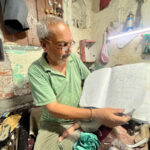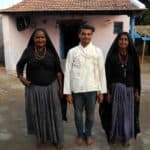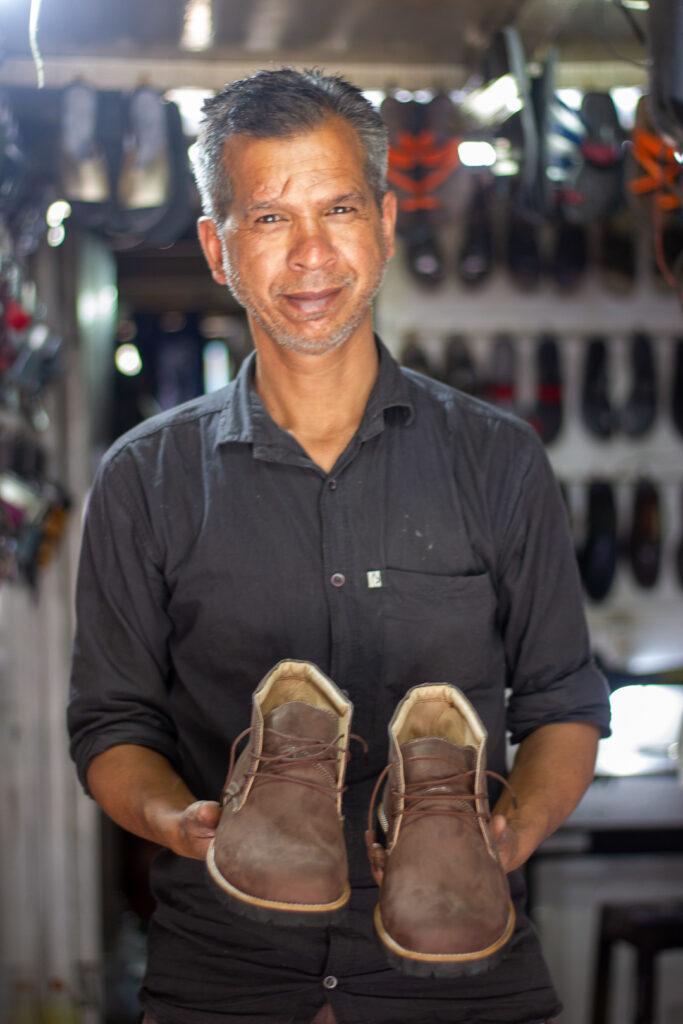
Author in shoes with invisible stitching lines at the joint, crafted by Sanjay and Kishen Shoemakers. Photo credit- LOkesh Ghai
A touching tribute from LOkesh Ghai of Sanjay, the master shoemaker.
It was one of my last days in Dehradun when I received a surprise call from Sanjay Shoemaker. His voice was cracking a little. “You have not visited the handicraft shoemaker yet, I am at his studio right now.” It took me a while to understand that he meant handicap, not handicraft. I had been studying the shoemakers in Doon Valley for three years with the support of the India Foundation for the Arts. I organised an exhibition in Dehradun, accompanied by a talk with master shoemakers and a successful heritage walk to the shoemakers in Mussoorie, with several friends coming forward to support this initiative. With this lead from Sanjay, I decided to visit another unsung artist, Ramesh, a shoemaker, during the last hours that marked the three years of my life in Dehradun.
The connection between the artisans helps them sustain small-scale craft businesses. Kishan Shoemaker humbly acknowledges that he is God-gifted to make the bottoms of the shoes, which he has been practising for the last fifty years. However, making the uppers of the shoes is not his expertise. He depends on Sanjay to make the uppers. Together, they make a team.
While Kishan is the face of the enterprise dealing with customers, Sanjay is less visible, working for Kishan, and perhaps none of the customers even know his name. He sits in the back of the studio shop quietly and diligently working. Sanjay typically starts the process of shoemaking by cutting the outer sole of the shoe and nailing it to the wooden last. He then carefully traces the patterns of the selected shoe style on the leather and cuts these after exploring various permutations to achieve the least wastage while taking the direction of the leather into account.
Sanjay patiently skives the edge of each pattern with a rapi, a process that requires additional skill, then he hand-punches the design details manually. As per the detail, at times, he uses pinking shears to re-cut the edges and a lighter to burn the edges to avoid the grain hair, pasting together patterns with interlinings and finally stitching the upper part of the shoes on a foot-operated sewing machine. It is an expertise to stitch just at the right distance from the edge of the pattern. Otherwise, all effort until this stage could be wasted. Sanjay then passes the half-made shoes to Kishan, who shapes them on the wooden last and finishes the shoes, with his role as a bottom man. The rhythm of Sanjay’s manually-operated sewing machine sometimes matches the retro Hindi film songs on the radio that he enjoys while at work.

Shoemakers of Mussoorie (left to right): Dishes, Anil, Baghatram, Kuldeep, Sanjay, Ashok, Sonu and Kishen against the Landour Clock-Tower. Photo credit- Aditi Dubey
Sanjay shares a friendship with shoemaker Sonu and his son Ranveer next door and usually ends his day with a stroll to their studio shop. On Sanjay’s suggestion, I got a pair of blue oxford bespoke shoes handcrafted, which, as a design detail, has an additional joint in the front but nowhere a stitch visible. I now see the invisible stitch, a metaphor for Sanjay’s life.
Today, I had another phone call from Kishen with a broken voice. Sanjay has passed away. He was only 48 years old. Sanjay had a complicated time in his life, with an early divorce still seen as a stigma in rural Indian society. Drinking had made his liver weak. On our last meeting, I accompanied him to a local chemist to buy him medicine. Sanjay’s health was deteriorating. Despite this, he always wore a smile. He had a happy face, even while he slept on the floor on the wintery nights. His last wish was for a warm jacket, which he had requested from my friend. I suggested finding him a new one over a second hand. It is hard to imagine his mother’s pain as she may have covered his face after his fall.
I mourn his death with the hope that his friend Ramesh, a shoemaker who he was excited to introduce me to, finds a better faith with more resilience to keep going in the face of the harshness of the life they lead.





Comments
A beautiful piece with emotions and yet showing light on the intricacies of the craft of the shoemakers
by giving such an emotional tribute, you have given an echo to the silence of the master shoemaker. by throwing a light on his work, he must have felt appreciated for his craft, the craft which couldn’t fetch him enough money to buy a warm jacket, but got him enough accolades at the last of his years to let him know the significance of his craft and that he was one of the few who could do it the way it should be done.
Lokesh Jee, this is a heartfelt and painful story about the unsung artists of our society. You have taken an amazing initiative to bring them and their art in front of society. My heartfelt condolences to Sanjay and his family. More power to you. Regards